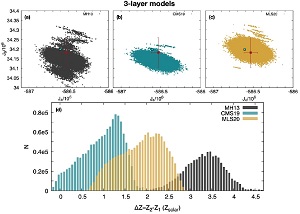Jupiter’s inhomogeneous envelope
- Details
- Published on 08 June 2022
Vol. 661
10. Planets and planetary systems
Jupiter’s inhomogeneous envelope

While Jupiter's gaseous envelope is mainly composed of hydrogen and helium, the distribution of the other (heavy) elements is a key constraint to its formation. Thanks to accurate measurements of Jupiter's gravitational moments (J2 to J10), the Juno mission is yielding unique information on Jupiter's internal structure and deep atmospheric winds. Building upon preliminary analyses of the Juno results, Miguel et al. present a comprehensive modeling of the gravity data, complemented by measured values of the helium abundance and metallicity in the observable atmosphere. Using both a three-layer model and a model that includes a dilute core as well as a variety of equations of state, they find that the ensemble of data can be satisfied only by invoking a gradient of metallicity, namely a heavy-element enrichment in the interior relative to the outer envelope. They further set an upper limit of 7 Earth masses for Jupiter’s inner core. The non-homogeneity of Jupiter's envelope implies that Jupiter continued to accrete heavy elements while its H2-He envelope was still growing, and that Jupiter's interior and outer envelope never fully mixed. This result favors the scenario of planetesimal ablation throughout the gas accretion phase over the pebble accretion scenario, in which solid accretion stops at the pebble isolation mass, but hybrid planetesimal-pebbles scenarios are also possible. While efforts are underway to determine exoplanet atmospheres' composition and metallicity from spectroscopic observations, the present study suggests that results will not necessarily be representative of the planets' bulk metallicities.


